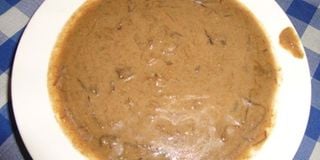Malewa, the traditional Gishu treat

The various ways Malewa can be prepaerd makes it one of the easiest and popular dishes one can choose. Photo by David Mafabi
What you need to know:
The tasty dish has taken on national prominence as it is no longer confined to only Bugishu.
The foothills of Mount Elgon in eastern Uganda are intricately linked to the history of the Bagisu people and the food they eat. Many a Mugishu (Mumasaba) believes in the legend that the first Mugishu man, Masaba, emerged from a cave on the slopes of Mount Elgon where the raw material for Bamboo shoots ‘Malewa’ grows wildly and widely.
It is believed that the mountain is home to the Bagishu gods and numerous cultural artefacts are sourced from the mountain. Mount Elgon, now a protected national park, has been and is also the source of a delicacy unique to the Bagishu that has been eaten by the people over 3,000 years, according to lore.
In Bugishu, once ‘Malewa’ is prepared, children will say they have prepared ‘Zinyinyi’ (sauce) and while they will say they have prepared ‘bilyo’ (food) if matooke has been prepared, this explains why the two are inseparable at most meals.
‘Malewa’ can be eaten as food once boiled but could also serve as sauce at most meals and can never be left out among the Bagishu (those hailing from Mbale, Manafwa, Bududa, Sironko, Bududa and Bulambuli).
The dried bamboo shoots, the malewa, are adored among the Bagishu. The dish has swept through the Bantu speaking tribes in the country and neighbouring Luo tribes, like Japadhola.
In Bugishu region, for those who have attended parties; graduation parties, circumcision ceremonies and marriage introduction ceremonies and even at weddings where buffets are prepared, if malewa is not prepared, the party is not complete.
Most Bagishu who have gone to live abroad once in a while when they come back into the country, will carry it privately in their luggage across the borders into Europe or America and these have also impressed the friends in diaspora who have come to accept that malewa is a delicious delicacy.
According to Mr John Musira, a cultural leader, malewa is thought to have been sought by Bagishu ancestors who lived in the caves at the slopes of Mt Elgon during wars in the 16th and 17th centuries.
“This mountain is very old, so when our people came from South Africa, reached Tanzania in Mwanza, they left some people here who are called Ngisu and moved to Kenya. But they found a lot of resistance. They were fought and chased without food up Mt Elgon, so while hiding in the caves, they started looking out for anything to eat,” said Mr Musira.
He reveals that it is in these caves that the Bagishu discovered that they could boil young bamboo shoots and eat them as food.
“So all the Bagishu who did not have food started eating it as food but later they discovered that it could also serve as sauce if mixed with Zikhanu, traditional Sim Sim or mulekula, also a traditional groundnut paste,” adds Mr Musira.
The malewa became popular and integrated in the entire Bugishu sub-region after the Bagishu started growing ground nuts as crop, making malewa and ground nuts part of the people’s culture. If bamboo shoots are dried up, cut into small pieces and cooked in ground nut sauce and served with matooke, one is bound to fall in love with it given the smoky aroma from malewa.
This delicacy can be served with matooke, cassava, traditional yams, sweet potatoes, posho (corn meal), Irish potatoes and even rice. Ms Wajega, the owner of Gombe Restaurant at Mbale Industrial Area, is widely known all over Mbale for her malewa. “Malewa could also be eaten in its raw form or just steamed and eaten as food in most homes in Bagishu,” said Ms Wajega.




